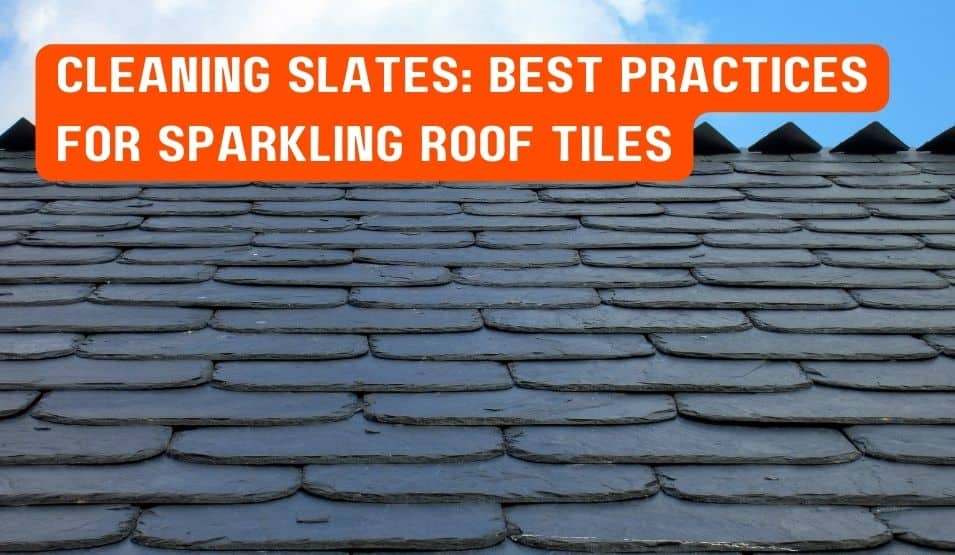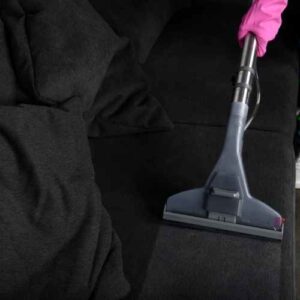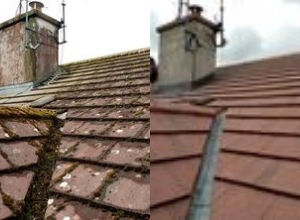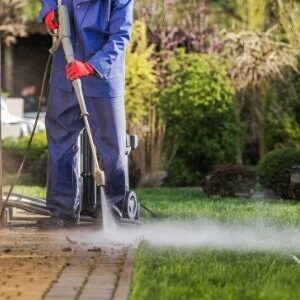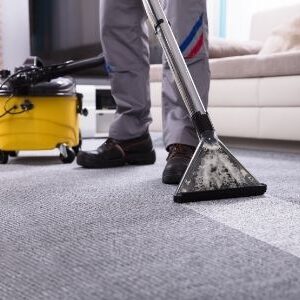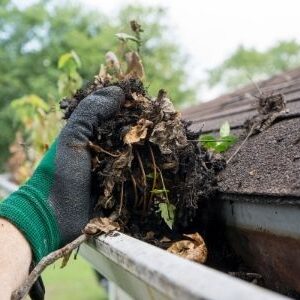Slate roofs, with their timeless charm and durability, have graced homes in Ireland for centuries. But, like all good things, they require a touch of care. Cleaning slates through roof cleaning is what keeps these architectural wonders looking resplendent and performing impeccably year after year.
Understanding Slate Roof Cleaning Essentials
Slate roofs are an investment, not just in the aesthetics of your home, but also in its protection against the elements. Made from natural or man-made material, these roof slates are known for their durability and appeal. However, regular slate roof cleaning is a key part of ensuring their durability and preserving their classic appeal. With proper slate roofing maintenance, you can enjoy the benefits of this timeless material for years to come.
Before cleaning slate roof tiles, understanding your slate type is essential. The type of slate used in your roof, whether it’s natural slate or a fibre cement variant, would determine the cleaning technique and care required. Natural slates may be delicate and may crack if not handled with care, so it’s important to be cautious during the cleaning process. Concrete roof tiles, on the other hand, are more robust but require a different cleaning approach. Therefore, determining your slate type is the initial stage of its effective preservation.
Identifying Your Slate Type
Slate roofs can be made from various materials, including:
- Natural slate
- Concrete slate
- Fibre cement slates
- Synthetic composite slate
Each type has its unique characteristics and requires a specific approach to cleaning and maintenance.
Determining your slate type isn’t as intimidating as it might appear. The appearance, weight, and installation method can give you clues about the material of your roof. Here are some factors to consider:
- Natural slate roofs generally have variations in colour, texture, and thickness, giving them a more natural look.
- Synthetic slate roofs tend to have a uniform appearance.
- Natural slate is heavier than synthetic slate, and its installation requires more expertise.
Assessing these factors can help you identify your slate type and determine the right cleaning approach.
Pre-Clean Inspection Tips
Before starting the cleaning process, you should:
- Inspect your slate roof thoroughly. This can help you spot any signs of damage, loose or missing tiles, or potential areas of concern.
- Remove any debris or mildew from between the tiles.
- Clean the gutters.
Look out for moss and algae formations on your roof. These not only affect the aesthetic appeal of your roof but can also lead to long-term damage if left untreated. The presence of green or black patches or streaks on the roof surface is a clear indication of these unwanted guests. Tools such as a slate hammer, slate cutter, and slate ripper are recommended for a thorough pre-clean inspection.
The Do’s and Don’ts of Slate Roof Cleaning – Cleaning Slates
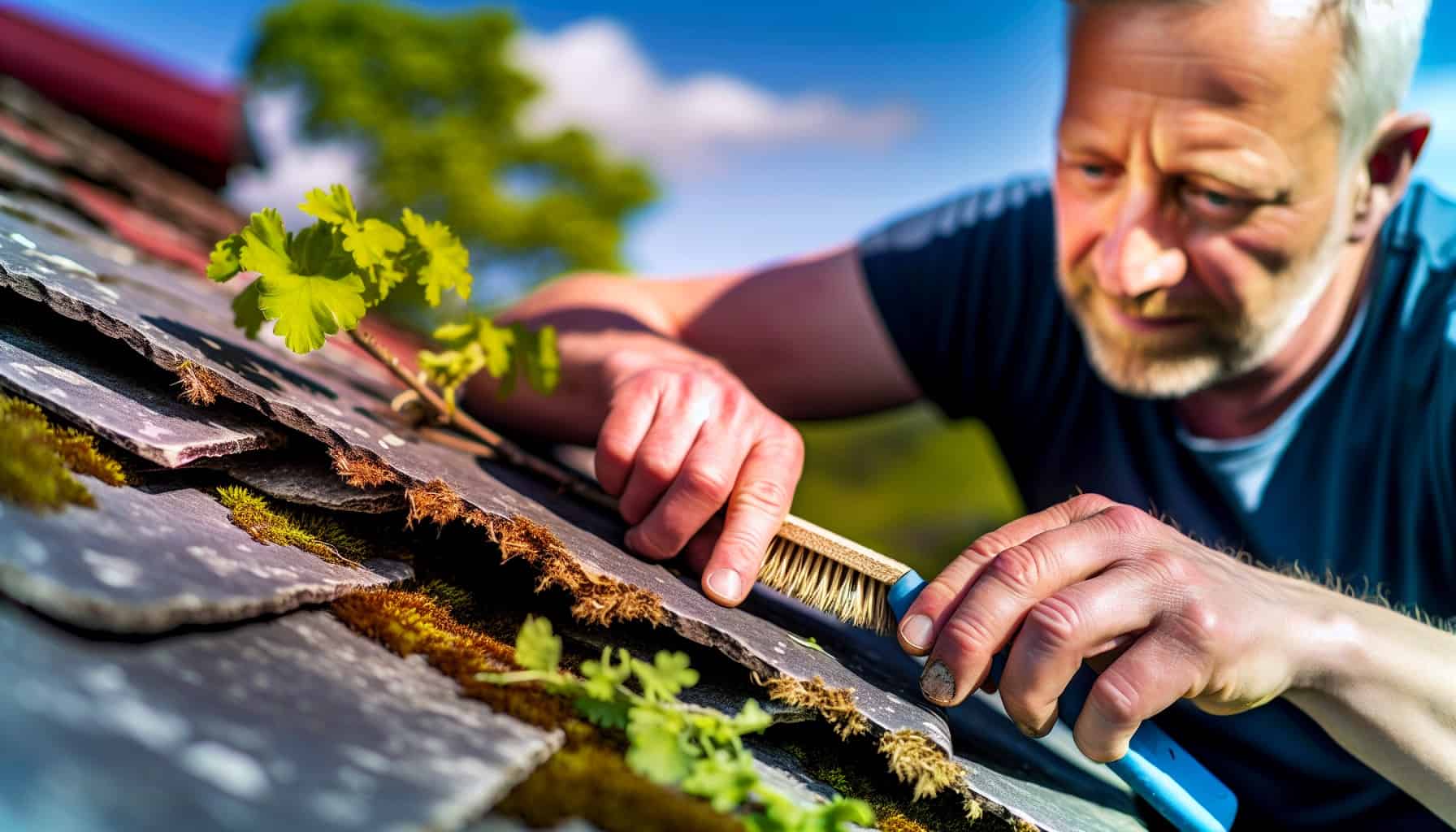
Slate roof cleaning isn’t about scrubbing forcefully, it’s about cleaning with precision and care. High-pressure water, including the use of pressure washers, should be avoided to prevent damage to slate tiles, especially older or damaged ones. Cleaning should be focused on:
- Removing organic debris such as moss and leaves
- Using a soft-bristle brush or broom to gently sweep away dirt and debris
- Using a mild detergent or slate cleaner to remove stains or discoloration
This helps to maintain an enjoyable exterior environment.
A mix of suitable roof slate cleaning products, such as household cleaner and water, can be used to remove moss and other stubborn stains. Use a medium-stiff brush to gently scrub the affected areas. But beware of the potential risks associated with using specific cleaning chemicals. For instance, copper may corrode when exposed to certain chemicals, such as chlorine bleach and ammonia, causing it to darken or tarnish prematurely.
Safe Removal of Organic Debris
Organic debris, including leaves and moss, can accumulate on your slate roof over time. While these might seem harmless, they can retain moisture, which, during colder weather, can freeze and lead to the splitting of slates. Thus, removing this organic debris safely and promptly is vital for the well-being of your roof.
While high-pressure water might seem like an effective way to quickly remove this debris, it’s more harmful than helpful. The high pressure could cause the slates to break apart, resulting in damage and potential leaks. It could also drive water up under the slates, leading to water infiltration and further damage. Hence, it’s advisable to use a soft-bristle brush, a leaf blower, or a plastic or rubber scraper for hassle-free debris removal.
Appropriate Cleaning Agents
The cleaning agents you opt for your slate roof can significantly impact the cleaning outcome. The wrong ones can cause chemical damage, while the right ones can restore the lustre of your roof without causing any harm.
When selecting a cleaning product, look for one that’s specifically designed for slate roofs. Mild detergents, non-acidic solutions, and biodegradable ingredients are your best bets. On the other hand, harsh chemicals, bleach, and acidic cleaners should be avoided as they can cause damage to the slate. Also, consider professional-grade products such as Roof Clean Xtreme, which is designed to clean and treat a variety of roof tiles, including slate and concrete.
Gentle Cleaning Techniques for Slate Roofs
A slate roof demands a gentle touch. Harsh cleaning techniques can do more harm than good, damaging the roof surface and shortening the lifespan of your slate roof. Hence, mild cleaning methods, like soft washing, are recommended for slate roofs.
Soft washing is a cleaning method that involves a low-pressure water spray combined with specialised cleaning solutions to remove dirt, algae, moss, mould, and mildew from the surface of the slate tiles. This method is preferred over using a pressure washer, pressure washing, and power washing as it is less likely to cause damage or break apart the slates.
The Role of Soft Washing
Soft washing is akin to providing your slate roof a gentle rejuvenation session. It involves using a low-pressure water spray combined with specialised cleaning solutions to remove dirt and organic growth from the surface of the slate tiles.
The process usually begins by applying the cleaning solution to the roof, allowing it to penetrate and break down the dirt and organic growth. Subsequently, a low-pressure water spray is used to rinse off the solution and remove the loosened debris.
Soft washing helps to maintain the integrity of the soft slate tiles and clay tiles while efficiently cleaning and restoring their appearance.
Targeting Moss and Algae
Moss and algae, though they may seem harmless, can cause long-term damage to your slate roof if left untreated. They can:
- Form a layer on the slate shingles
- Trap moisture underneath
- Potentially lead to damage
- Reduce the lifespan of the roof.
Effective removal of moss and algae involves:
- Using a soft-bristle brush
- Using an eco-friendly roof moss remover
- Using natural remedies such as vinegar, baking soda, or a mixture of water and vinegar
These methods can be effective in killing off moss and algae.
Consistent removal of moss and algae is vital for preserving the well-being of your slate roof.
When to Call Professional Slate Roof Cleaners
While routine upkeep can maintain the good condition of your slate roof, there might be instances when professional cleaning is needed. If you’re unsure about the cleaning process or if the roof requires extensive cleaning and maintenance, it’s advisable to hire professional slate roof cleaners such as Spooners Cleaning.
Professional roof cleaners are equipped to handle severe damages such as missing or cracked tiles, water stains, and algae growth. They are trained to handle the delicate slate tiles, preventing any damage that could occur due to improper cleaning techniques. So, when in doubt, it’s best to call in the experts!
Enhancing the Lifespan of Your Slate Roof through Cleaning Slates
A slate roof is not just a roof, it’s a long-term investment. With proper care and maintenance, a slate roof can last between 50 and 200 years. Thus, enhancing the lifespan of your slate roof not only protects your investment but also adds to the value of your home.
Routine preservation tasks for a slate roof include:
- Regular inspections
- Cleaning
- Gutter upkeep
- Prompt repairs
Refraining from walking on the roof and hiring professional roof cleaners when required also contribute to the longevity of your roof. If you live in Laois or nearby counties, our roof cleaners would be delighted to keep your roof slates cleaned and maintained twice a year.
Protecting Your Investment: The Importance of Regular Slate Roof Maintenance
Your slate roof is not only a functional component of your home but also an investment that boosts your property’s value and aesthetic appeal. Protecting this investment involves regular slate roof maintenance.
Regular maintenance helps keep gutters and downspouts uncluttered, provides durability, safeguards against water damage, and results in cost savings in the long term. Failing to adhere to proper maintenance protocols can lead to:
- leaks
- missing or cracked tiles
- increased energy costs
- potential pest infestations
Hence, routine upkeep is essential to safeguard your investment and make sure your slate roof endures over time.
A slate roof, with its timeless appeal and durability, is a long-term investment that requires care and maintenance. Regular inspection and maintenance of slate joints and sealants, and hiring professional slate cleaners can greatly enhance the lifespan of your slate roof. Ultimately, protecting your investment means committing to regular maintenance and treating your slate roof with the care it deserves.
Contact us today for a consultation and experience the superior benefits of professional slate roof cleaning.
Frequently Asked Questions
What is the best way to clean roof slates?
For best results, gently scrub roof slates with a medium-stiff brush and a mix of household cleaner and water to remove moss, mould and rust.
Should a slate roof be cleaned?
Regular slate roof cleanings are essential to protect the integrity of both the slate and your home; mould, moss, and lichen buildup can cause serious damage.
Can you pressure-wash slate tiles?
It is not recommended to pressure wash slate tiles, as strong chemicals and a pressure washer can damage them.
How do you get stains out of slate tiles?
Mix a solution of warm water and mild detergent, or use equal parts water and hydrogen peroxide and rub with a brush or sponge; if these don’t work, try using a commercial stone cleaner specifically designed for hard water stains.
How can I identify my slate type?
To identify the type of slate roof you have, examine its appearance, weight, and installation method. This should give you an idea of the material used.

